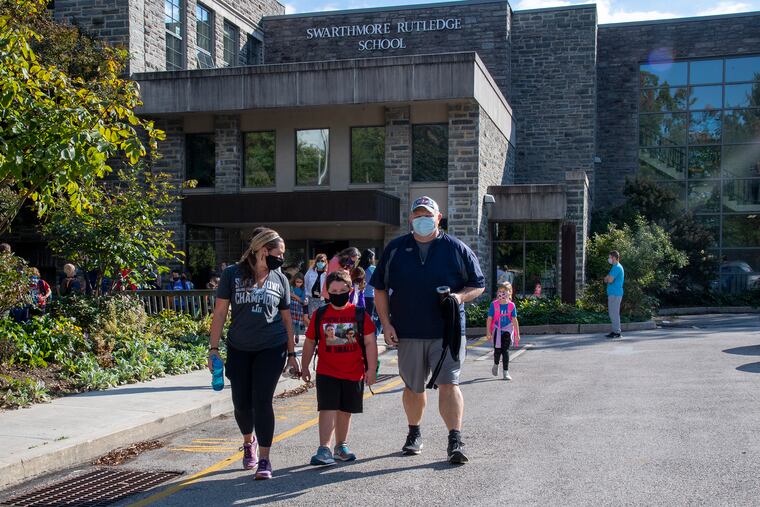Hybrid school is finally here. It is not perfect, but ‘the kids are happy.’ | Maria Panaritis
Masked children are finally back in classrooms in some Philadelphia suburbs. If only President Trump had half the discipline of a 6-year-old.

Howard Collier’s empty school bus beckoned.
The 73-year-old retired SEPTA man had just parked his baby, School Bus No. 17, alongside Swarthmore-Rutledge elementary school. I peeked inside from the sidewalk through open accordion doors.
“I’ve been on this route for five years,” Collier said Monday afternoon. “The kids know me. The parents know me. When they’re on my bus, they’re my kids.”
For children inside the school at that moment, Monday was the first time they had been back inside a classroom since the coronavirus shut down schools in March. Wallingford-Swarthmore School District is among a select number of suburban Philadelphia districts that have begun reopening to partial-week instruction. It is momentous for children and parents alike in this ever-so-disorienting pandemic year.
A fraction of what so many of us have lost during this terribly managed coronavirus pandemic was visible right there inside Collier’s idled school bus. A bus that, in a normal year, is packed with spunky kids who like to needle — and be needled by — the driver they all call “Mister Howard!”
“I had two brothers this morning,” Collier said, and for a moment I thought he was singling out a pair on a reasonably full bus.
I was wrong.
He had two kids total on the whole bus Monday morning.
“I don’t see any relief from this whole mess,” he said of the pandemic and its effect on our lives, still.
I had dropped off my own sons at school in a different district Monday for their own stab at two days a week of in-person instruction. It’s all that crowded public schools can manage without turning classrooms into the kind of petri dish that President Donald Trump apparently has been presiding over at the White House.
What I saw in both districts was, like so much else in this crazy year, a confusing if also welcome scene: Kids and adults wearing masks without flinching. A crowd at less than half capacity. Everyone marching through a New Normal that does not feel normal, even though the numbness of this terrible year makes today feel slightly better than yesterday, and last week, and the month before that.
For six long months (and counting in Philadelphia and other districts that have yet to reopen their actual classrooms at all), schools had been shuttered.
The sound of them back on the scene, if in shockingly fewer numbers due to staggering of schedules and decisions by other families to stay home, was glorious.
» READ MORE: Zoom and gloom: Virtual schooling has begun, and it is unsustainable | Maria Panaritis
“They launched like a rocket!” I heard a teacher say from beneath a canopy of trees just outside the Swarthmore elementary school’s front doors. I was sitting on a wooden bench nearby, eavesdropping. She held open a hardback book and dangled it over eight masked first graders seated on the grass in criss-cross applesauce style. They were reading The Awful Aardvarks Go to School.
The children chirped. It was like a burst of oxygen in a smothering forest fire. I kept turning my eyes toward a nearby mylar balloon tied to a wooden bench. It swayed in the sunny, crisp pre-Halloween air. “WELCOME BACK,” it said.
“Now listen carefully, my first graders,” the teacher continued. “We’re going to go back into the classroom. We’re going to wash our hands, and then it’s time for a snack.”
The children marched past me at six-feet-apart intervals. One little boy appeared to be talking animatedly about a tiny creature.
“I learned about it on Wild Kratts,” he told a classmate as they breezed past. “It’s the size of a tip of a pin!”
The return of children to even just some of our region’s suburban schools, while a huge milestone, was also bittersweet given the backdrop of drama in the White House. Our mask-averse president was hospitalized until Monday evening with COVID-19. He had been whisked to the hospital Friday via helicopter, for all the world to see, a portrait of hypocrisy and ineptitude. The fearless leader who spent much of the year talking down masks and doing little to nothing to help public schools reopen with resources to do so safely, was in the hospital while children finally began to squeeze out a few hours of school again, no thanks to his incompetent administration.
“I’m happy for my son,” Christine Anderson said of 6-year-old first-grader R.J. Contraday, moments before he emerged from his first day back since March. “He shed a couple of tears this morning.”
» READ MORE: Lansdowne grandparents struggle with virtual schooling: ‘It’s rough on us’ | Maria Panaritis
All around, parents and kids were wearing masks. No one was whining about personal liberty or politics. They were acting, in other words, like grown-ups act when a common goal is identified that requires a touch of communal sacrifice.
I asked Cora Alessi, 43, after she greeted her fifth- and first-grade children, what she thought of the year. Her attention turned to Trump.
“I thought it was ironic that he got sick,” Alessi said. “The one person opposed to a mask got sick.”
Principal Angela Tuck and kindergarten teacher Ellen Coopersmith said they heard children laughing all through the halls.
“We played ‘Welcome Back Kotter’ on the public address system,” Tuck said. Children were so glad to be back, they couldn’t believe they could see each other again in the flesh.
“One little girl actually said, ‘I wish there wasn’t any COVID,’” Coopersmith said. But — and here is where the light of this dark time can, indeed, be found: “The kids are not scared.”
“The kids,” she added, “are happy.”